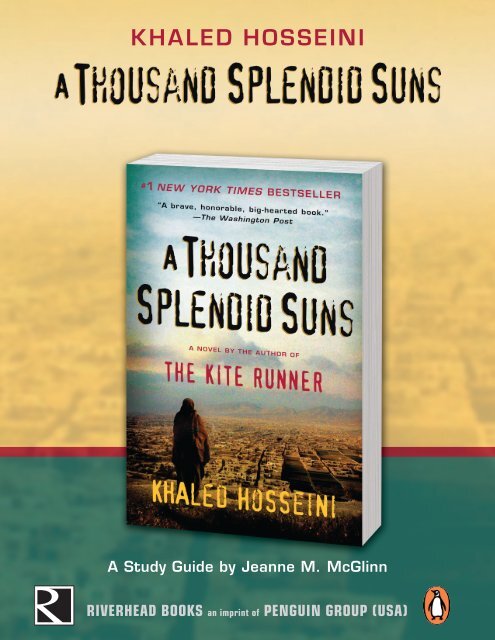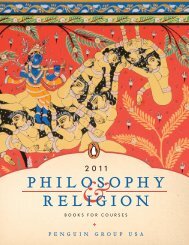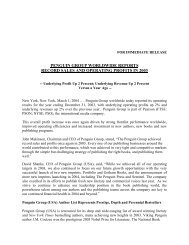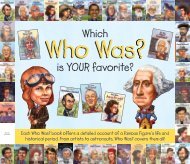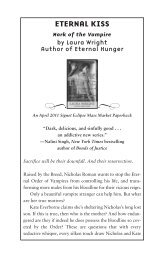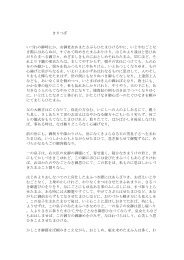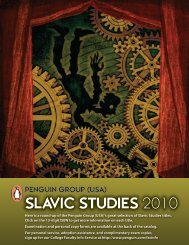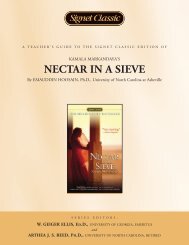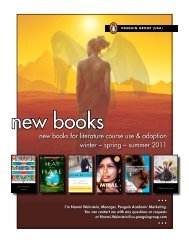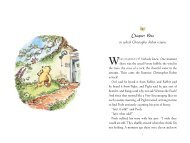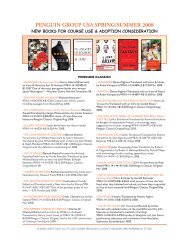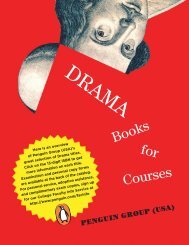KHALED HOSSEINI - Penguin Group
KHALED HOSSEINI - Penguin Group
KHALED HOSSEINI - Penguin Group
You also want an ePaper? Increase the reach of your titles
YUMPU automatically turns print PDFs into web optimized ePapers that Google loves.
<strong>KHALED</strong> <strong>HOSSEINI</strong><br />
A Study Guide by Jeanne M. McGlinn<br />
RiveRhead Books an imprint of PeNGUiN GRoUP (Usa)
INTRODUCTION<br />
A Thousand Splendid Suns tells the intertwined stories of the lives of two Afghan women, Mariam<br />
and Laila, both married to the same abusive man, during the years of the Soviet occupation, then<br />
the civil war and the Taliban dictatorship. This guide is designed to aid teachers in selecting resources<br />
that provide background to the novel. It also provides discussion questions and activities<br />
for before, during, and after reading the novel. Teachers can select the activities which best fit the<br />
needs of their students. This guide may also be useful to independent readers of the novel who<br />
are looking for resources to guide their reading.<br />
ABOUT THE AUTHOR<br />
Biographies of the author are available at several different<br />
web sites. This short biography provides a link to the<br />
Khaled Hosseini Foundation which Hosseini set up following<br />
a trip to Afghanistan in 2007 for the United Nations<br />
High Commissioner for Refugees (UNHCR):<br />
http://www.khaledhosseini.com/hosseini-bio.html.<br />
Hosseini was selected as a Goodwill Envoy to UNHCR in<br />
the United States in 2006. UNHCR was established in 1950<br />
to lead international efforts to protect and provide solutions<br />
for refugee problems. In June of 2006 after receiving a<br />
HISTORICAL OVERVIEW OF AFGHANISTAN<br />
1. Students will benefit from an overview of the geography,<br />
history, and rich culture of Afghanistan. One reliable<br />
source which can serve as an introduction is<br />
the CIA World Factbook: https://www.cia.gov/library/publications/the-world-factbook/geos/af.html<br />
Here students can learn significant facts about the<br />
political history, geography, government, and people.<br />
2. “Google maps” provides an excellent map of the<br />
country. Students can select satellite and terrain<br />
views and can manipulate the map to view the country’s<br />
borders and land features. During reading, students<br />
can trace the journey of Mariam when she<br />
leaves Herat, the city where she was born, for Kabul.<br />
When Tariq returns to Kabul he describes the journey<br />
of his family as refugees (p. 334). Later Laila<br />
goes to Murree in Pakistan to live with Tariq until<br />
the war is over. Then she makes a return trip to<br />
Herat, through Mashad in Iran (p. 392).<br />
Students can look at a city map of Kabul to locate<br />
the neighborhood where Mariam lives. Rasheed describes<br />
Deh-Mazang in detail and the surrounding<br />
mountains: “In the south and west part of the city.<br />
The zoo is nearby, and the university too” (p. 57)<br />
humanitarian award from the agency, Hosseini was asked<br />
to serve as a goodwill ambassador. This site has an interview<br />
with Hosseini about his service to the UNHCR:<br />
http://www.unhcr.org/45d574692.html?gclid=CKjQ5ZS<br />
vlZ4CFdA65QodFhf6pg.<br />
Hosseini was inducted into the Academy of Achievement<br />
in 2008. At this site you can listen to a podcast in which<br />
Hosseini describes why he became a writer: http://www.<br />
achievement.org/autodoc/podcasts/artpod-4-hosseini-vid.<br />
“That’s the Asmai mountain directly in front of us …<br />
to the left, is the Ali Abad mountain…Behind us,<br />
east…is the Shir Darwaza mountain” (p. 59).<br />
3. Hosseini weaves the history of Afghanistan throughout<br />
the novel, starting in chapter 4 when Mariam’s<br />
father tells her about the bloodless coup of King Zahir<br />
Shah who had ruled for forty years. Ask students<br />
to begin to keep a timeline of these political/historical<br />
facts in their reading journals or as a class project<br />
on charts which will be posted in the class room for<br />
easy reference. Students can note the historic event at<br />
the top of the chart and the personal events of the<br />
main characters underneath. In this way students will<br />
begin to see how the personal events in the lives of<br />
the two women are affected by the events taking<br />
place in the wider world.<br />
4. According to the web site of the International Campaign<br />
to Ban Landmines, (http://www.afghan-network.net/Landmines/,<br />
Afghanistan has the heaviest<br />
concentration of landmines of any country in the<br />
world. Ask students to read this web article and then<br />
to locate two other articles on the web to cross check<br />
the statistics. Ask students to prepare a power point<br />
2 A STUDY GUIDE TO <strong>KHALED</strong> <strong>HOSSEINI</strong>’S A THOUSAND SPLENDID SUNS
or web “scrap book” of the main facts they discover<br />
about the landmine problem and its impact on the<br />
citizens of Afghanistan.<br />
5. Throughout the novel, readers are reminded of Afghanistan’s<br />
ethnic diversity. For example, when Mariam<br />
is forced to marry Rasheed, her father’s wives assure<br />
her that he speaks Farsi even though he is a<br />
Pashtun. Mariam is a Tajik. Students can read about<br />
the different people who make up the ethnic diversity<br />
of Afghanistan at:<br />
BEFORE READING<br />
1. A Thousand Splendid Suns takes its title from a poem<br />
by the 17th century Persian poet Saib-e-Tabrizi which<br />
can be found at this site:<br />
http://www.afghan-network.net/Culture/kabul_<br />
poem.html<br />
Ask students to read the poem and make a list of the<br />
images the poet uses to praise the city of Kabul. Ask<br />
students if they have read other poems of praise,<br />
called odes. You might ask if they have read the odes<br />
of the Romantic poets: Keats’ “Ode on a Grecian<br />
Urn” or Shelley’s “Ode to the West Wind.” An ode<br />
uses hyperbole and inflated language to glorify and<br />
enhance the subject and to create feelings of appreciation<br />
in the listener.<br />
Discuss: What do you learn about Kabul from reading<br />
this poem? What is your favorite image in this<br />
poem? What is the poet’s purpose? Does the poet<br />
succeed in creating a sense of the beauty of Kabul?<br />
2. Although Afghanistan is very much in the news, students<br />
may have a vague understanding of the history<br />
of the war since 2001 and the impact upon the citi-<br />
THEMES<br />
Students may explore the following themes while reading<br />
the novel:<br />
• Man’s inhumanity to man<br />
• Systematic victimization of women by patriarchal<br />
institutions<br />
• Spousal abuse<br />
• Resistance to victimization<br />
• Power of education<br />
• Education for women<br />
• Corrupting influence of absolute power<br />
http://www.pbs.org/newshour/indepth_coverage/<br />
asia/afghanistan/map_flash.html<br />
A Lesson Plan at this web site provides useful graphics,<br />
representing the distribution of ethnic groups. Ask<br />
students to note references to ethnicity as they read.<br />
Is the ethnic difference negative or positive? Are people<br />
treated differently because of their ethnicity? How do<br />
these perceptions affect people’s interactions? What<br />
other barriers to national unity are evident in Hosseini’s<br />
description of the people and their history?<br />
zens of this country. Ask students to read and make a<br />
list of what they learn from current news stories about<br />
the war in Afghanistan, the current political situation,<br />
and other issues confronting the people. Post<br />
these lists for students to review as they read the novel.<br />
Discuss how the situation is changing for the people.<br />
Is it improving or getting worse? After students<br />
have reviewed the news stories, discuss their sense of<br />
the future of Afghanistan. What are the problems<br />
facing the nation? Do they see things improving and<br />
in what ways?<br />
3. Both Mariam and Laila are victims of spousal abuse.<br />
Before reading the novel, ask students to read one or<br />
more articles on identifying the signs of spousal<br />
abuse, such as this list of the classic signs and symptoms<br />
of abuse at:<br />
http://www.abusefacts.com/articles/Classic.php<br />
Make a chart outlining the roles of the abuser and<br />
the abused. Post this chart so that as students read,<br />
they can identify and note plot events that match<br />
these signs of abuse.<br />
Introduce students to this list of themes and make sure<br />
that they understand what each theme means. Ask students<br />
to note particular themes in their reading journals<br />
or on post-it notes as they read the novel. After students<br />
have read several chapters, ask them to review their journal<br />
or post-it notes to identify what they consider the<br />
main theme of this particular section of the novel. List<br />
the theme(s) on a large chart and brainstorm the author’s<br />
possible meanings. Ask students: What is happening?<br />
Why is it important or significant? What does it mean?<br />
What is the author saying about this theme?<br />
3 A STUDY GUIDE TO <strong>KHALED</strong> <strong>HOSSEINI</strong>’S A THOUSAND SPLENDID SUNS
DURING READING<br />
Building Vocabulary<br />
through Context Clues<br />
The novel introduces students to Farsi words which they can<br />
understand using context clues. For example, Nana speaking<br />
about her father says, “He didn’t have the dil, the heart,<br />
for it” (p. 7). Students can infer that Nana is speaking<br />
about courage, the ability to stand up to do the right thing.<br />
Ask students to collect these words (they are italicized) as<br />
they read in a vocabulary notebook, by copying the passage<br />
in which the word is used on one side of their notebook<br />
page and then explaining the meaning of the word<br />
based on context clues on the other side. When there are<br />
words that are difficult to decipher, students can work together<br />
to determine the best meaning.<br />
Building Vocabulary through<br />
Self-Selected Vocabulary Strategy<br />
Students can build their vocabulary when reading the<br />
novel by selecting words that are new to them. Students<br />
should collect words in a vocabulary notebook. Ask students<br />
to divide the page in half. They should write the<br />
word on one side and the dictionary definition on the<br />
other side. Each week students can contribute one of<br />
their words to a vocabulary wall based on the novel.<br />
Discussion Questions and<br />
Reader Response Quotes<br />
You can use the following questions to engage students in<br />
thinking about the characters, the plot, and what it means<br />
to us as readers. These questions can be adapted for reader<br />
response or as starters for small and whole group discussions.<br />
Reader response prompts are open-ended, asking<br />
students to articulate their reactions to a scene or development<br />
in the plot. Discussion questions generally build<br />
on students’ literal recall of the plot to build up inferences<br />
about what these events mean and what they tell the reader<br />
about the overall meaning of the narrative. Students go<br />
back to the text to identify and analyze key passages as<br />
they build meaning. Students can use the quotes or choose<br />
their own quotes as they read, explaining the meaning of<br />
the quote and its significance in their reading journals.<br />
I. Part One Chapters 1-15<br />
1. The novel opens with a curse word, uttered in frustration<br />
by Mariam’s mother, when Mariam breaks a<br />
treasured heirloom. What does Mariam’s memory of<br />
this suggest about her sense of herself and her relationship<br />
with her mother? How does this opening set<br />
the tone for the novel?<br />
2. Based on Nana’s and Mariam’s experiences, what can<br />
you infer about the lives of women in Afghanistan in<br />
the sixties? Why does Nana forbid Mariam to go to<br />
school? What does Nana want for her and Mariam?<br />
Is Nana’s goal realistic?<br />
3. Jalil, Mariam’s father, is a complex character. Does he<br />
love his daughter? How does he show his love? How<br />
does he show that he does not fully recognize her as<br />
his daughter? Why does he treat her as he does?<br />
4. Why does Mariam ask her father to take her to the<br />
cinema for her fifteenth birthday present? What does<br />
she want?<br />
5. Is Mariam right to feel guilt about the suicide death<br />
of her mother?<br />
6. What is the motive of Jalil’s wives in finding a suitor<br />
for Mariam? Why does Jalil go along with them in<br />
this plan?<br />
7. Why does Mariam finally say “yes” in the marriage<br />
ceremony to Rasheed? What does Mariam realize about<br />
her father? How does that make her feel? Does this explain<br />
why she goes along with the marriage to Rasheed?<br />
8. The beginning of Mariam’s marriage to Rasheed seems<br />
to promise happiness. What are signs that this may<br />
be short lived?<br />
9. How does Rasheed feel about the westernization of<br />
Afghanistan? What shows his ambivalence?<br />
10. What are Rasheed’s reasons for making Mariam wear<br />
a burqa and what do they tell us about his ideas about<br />
his role as a husband and man and his expectations<br />
for Mariam?<br />
11. Mariam learns some of her husband’s history when<br />
she looks inside the drawers in his room. Why does<br />
she rationalize about what she sees?<br />
12. Why does Rasheed want a boy? How might life have<br />
been different for the family if Mariam could have<br />
had a baby?<br />
13. Why does Rasheed become abusive?<br />
4 A STUDY GUIDE TO <strong>KHALED</strong> <strong>HOSSEINI</strong>’S A THOUSAND SPLENDID SUNS
Reader Response Quotes<br />
“She [Mariam] was being sent away because she was the<br />
walking, breathing embodiment of their shame.” (p. 48)<br />
“I thought about you all the time. I used to pray that<br />
you’d live to be a hundred years old. …I didn’t know that<br />
you were ashamed of me.” (p. 55)<br />
“Where I come from, a woman’s face is her husband’s<br />
business only.” (p. 70)<br />
“Mariam grieved for this baby, this particular child, who<br />
had made her so happy for a while.” (p. 93)<br />
“But after four years of marriage, Mariam saw clearly how<br />
much a woman could tolerate when she was afraid.” (p. 98)<br />
II. Part Two Chapters 16-26<br />
1. In this section we are introduced to nine-year-old<br />
Laila and her family. What were Laila’s parents like<br />
when they were young? How have they changed?<br />
What is undermining their relationship? How does<br />
their relationship affect Laila?<br />
2. Why does Laila feel such a strong attachment to<br />
her father?<br />
3. Why does Laila’s father believe in the importance<br />
of education for women?<br />
4. What is wrong with Laila’s mother?<br />
5. Laila’s friend, Tariq, lost one leg to a land mine explosion<br />
when he was five. How does Tariq deal with his<br />
disability? What does his behavior suggest about his<br />
character?<br />
6. Laila enjoys spending time with Tariq’s family. How<br />
does her family differ from Tariq’s and why?<br />
7. How is Laila’s family affected by the deaths of their<br />
two sons? How do you understand Laila’s reaction?<br />
8. What is the role of religion in the novel? Does it give<br />
consolation to the people?<br />
9. Why were Laila’s brothers fighting? What are the motives<br />
for the rebels fighting against the communists?<br />
10. Why does Laila’s father take her to see the two Buddhas<br />
at Bamiyan? Later these statues are destroyed by the<br />
Taliban. Why?<br />
11. Why does Laila’s father stay with his wife? How are<br />
the mother’s and father’s dreams different and why?<br />
12. On their outing Laila’s father relaxes, re-reading<br />
Hemingway’s Old Man and the Sea. Why does the<br />
novel resonate with the father?<br />
13. In what ways is Laila like her mother, and in what<br />
ways is she like her father?<br />
14. How does the relationship of Laila and Tariq change?<br />
15. What is the impact of the Soviet withdrawal on the<br />
citizens of Kabul?<br />
16. What finally convinces Laila’s mother to leave Kabul?<br />
17. How do Laila’s feelings about leaving Kabul contrast<br />
with her parents’ feelings?<br />
Reader Response Quotes<br />
“Babi had made it clear to Laila from a young age that<br />
the most important thing in his life, after her safety, was<br />
her schooling.” (p. 114)<br />
“People…shouldn’t be allowed to have new children if<br />
they’d already given away all their love to their old ones.<br />
It wasn’t fair.” (p. 119)<br />
“To me, it’s nonsense—and very dangerous nonsense at<br />
that--all this talk of I’m Tajik and you’re Pashtun and he’s<br />
Hazara and she’s Uzbek. We’re all Afghans, and that’s all<br />
that should matter.” (p. 130)<br />
“Women have always had it hard in this country, Laila, but<br />
they’re probably more free now, under the communists, and<br />
have more rights than they’ve ever had before….” (p. 135)<br />
“But Laila knew that her future was no match for her<br />
brothers’ past.” (p. 142).<br />
“Laila knew that the days of innocent, unhindered frolicking<br />
in the streets with Tariq had passed. For some time<br />
now, Laila had begun to sense a new strangeness when<br />
the two of them were out in public.” (p. 163)<br />
“The Mujahideen, armed to the teeth but now lacking a<br />
common enemy, had found the enemy in each other.<br />
Kabul’s day of reckoning had come at last.” (p. 172)<br />
III. Part Three Chapters 27-47<br />
1. Rasheed digs Laila out of the rubble of the explosion<br />
that kills her mother and father and takes her into<br />
his home. Does his behavior seem unusual? What are<br />
his motives for taking care of Laila?<br />
2. How has U.S. foreign policy led to the continuing<br />
chaos in Afghanistan?<br />
3. Why does Laila agree to marry Rasheed, a sixty-year-old<br />
man, even when she considered the act dishonorable?<br />
4. Why does Rasheed demand total submission from<br />
the two women?<br />
5. Why does Mariam blame Laila for marrying Rasheed?<br />
Why does she see Laila as a competitor for Rasheed?<br />
5 A STUDY GUIDE TO <strong>KHALED</strong> <strong>HOSSEINI</strong>’S A THOUSAND SPLENDID SUNS
6. How has the death of his son affected Rasheed?<br />
7. Why does Rasheed continue to taunt Mariam when<br />
he has absolute control over her?<br />
8. What is the effect of wearing a burqa on Laila?<br />
9. What are Mariam’s changing feelings as Rasheed<br />
becomes more upset with Laila?<br />
10. What is the significance of Mariam and Laila having<br />
tea together?<br />
11. How is the violence in the streets of Kabul parallel to<br />
the violence in Rasheed’s home?<br />
12. Mariam and Laila ask a young man for help when they<br />
are trying to leave Kabul. Why does he betray them<br />
to the soldiers?<br />
13. Why has Rasheed become so cruel to Mariam and<br />
Laila? How has the breakdown of society, as a result<br />
of the war, allowed this to happen?<br />
14. How does the presence of the Taliban in Kabul affect<br />
Rasheed differently from Laila?<br />
15. Why does Laila not go through with aborting<br />
Rasheed’s baby?<br />
16. What does Mariam come to understand about<br />
motherhood?<br />
17. How is Laila’s son being educated in the male-dominated<br />
culture of the Taliban? How does Zalmai show<br />
that he is following his father’s example in how he responds<br />
to Laila and Mariam? How is Laila’s daughter<br />
taught to conform to the role laid out for women?<br />
18. What is it about the movie, Titanic, that is so interesting<br />
to the people of Kabul?<br />
19. Why does Laila confront Rasheed with his inability<br />
to keep a job when she risks being beaten by him?<br />
20. How does Mariam feel when she finds out that her<br />
father tried to visit her when he was dying and she<br />
refused to see him?<br />
21. What does the suffering that Laila endures to visit<br />
her daughter in the orphanage say about the Taliban’s<br />
effect on society?<br />
22. How is Aziza changing in the orphanage?<br />
23. Is Mariam justified in killing Rasheed? How is the<br />
act of murder a kind of fulfillment for Mariam?<br />
24. After the murder of Rasheed, how has the relationship<br />
between Mariam and Laila changed?<br />
25. How will Laila’s lying to her son affect him when he<br />
realizes the truth?<br />
26. What enables Mariam to have the courage to bring<br />
about Laila’s escape from Rasheed’s home?<br />
27. Why does Mariam request no visitors when she is<br />
put in prison?<br />
28. What is ironic in what the judge says to Mariam<br />
about carrying out God’s laws?<br />
29. How does Mariam show that she has grown into a<br />
woman of strong character before her death?<br />
30. How does Mariam find peace before she dies?<br />
Reader Response Quotes<br />
“I have friends who have two, three, four wives. … what I’m<br />
doing now most men I know would have done long ago.”<br />
(p. 215)<br />
“She knew that what she was doing was dishonorable.<br />
Dishonorable, disingenuous, and shameful. And spectacularly<br />
unfair to Mariam. … Laila already saw the sacrifices<br />
a mother had to make. Virtue was only the first.” (p. 219)<br />
“…I am your husband now, and it falls on me to guard<br />
not only your honor but ours …. That is the husband’s<br />
burden.” (p. 223)<br />
“… for the first time, it was not an adversary’s face Laila<br />
saw but a face of grievances unspoken, burdens gone unprotested,<br />
a destiny submitted to and endured.” (p. 249)<br />
“…she [Mariam] marveled at how, after all these years of<br />
rattling loose, she had found in this little creature [Aziza]<br />
the first true connection in her life of false, failed connections.”<br />
(p. 252)<br />
“What a man does in his home is his business.” (p. 266)<br />
“It seemed worthwhile, if absurdly so, to have endured all<br />
they’d endured for this one crowning moment, for this act<br />
of defiance that would end the suffering of all indignities.”<br />
(300)<br />
“He’d not been a good father, it was true, but how ordinary<br />
his faults seemed now, how forgivable, when compared<br />
to Rasheed’s malice, or to the brutality and violence<br />
that she had seen men inflict on one another.” (p. 309)<br />
6 A STUDY GUIDE TO <strong>KHALED</strong> <strong>HOSSEINI</strong>’S A THOUSAND SPLENDID SUNS
“The more Tariq talked, the more Laila dreaded the moment<br />
when he would stop. The silence that would follow,<br />
the signal that it was her turn to give account, to provide<br />
the why and how and when, to make official what he<br />
surely already knew.” (p. 337)<br />
“Mariam saw now in those same eyes what a fool she had<br />
been.” (p. 346)<br />
“I’ll never escape your son’s grief.” (p. 358)<br />
“God made us differently, you women and us men. Our<br />
brains are different. You are not able to think like we can.”<br />
(p. 365)<br />
“…she was leaving the world as a woman who had loved<br />
and been loved back.” (p. 370)<br />
Part Four Chapters 48-51<br />
1. How does Laila’s life in Murree contrast with her life<br />
in Kabul?<br />
2. Is Laila’s expectation that Zalmai will learn to accept<br />
his father’s absence realistic?<br />
3. Will Laila’s nightmares about her life in Kabul ever cease?<br />
What is the worst thing that happened to her there?<br />
4. Why is Laila afraid to hope for peace in Afghanistan,<br />
after the U.S. war on the Taliban is over?<br />
AFTER READING ACTIVITIES<br />
Discussion activities, thematic explorations, and creative<br />
exercises after reading the novel are designed to get students<br />
to re-read and think critically about their initial reactions.<br />
Most of these activities can be done with a partner or in a<br />
small reading circle. Again teachers should choose the activities<br />
that best meet their goals for students.<br />
1. Examine the role of religion in the lives of the main<br />
characters. Divide the class into three groups, assigned<br />
to Mariam, Rasheed, and Laila. Ask students to go<br />
back through the novel, noting the references to religious<br />
training, prayer, and the characters’ references to<br />
Allah, the Prophet, or the Koran. Based on this review,<br />
ask students to write a profile of the character, emphasizing<br />
their religious upbringing and orientation.<br />
Discuss as a group: Who is the most religious person<br />
in the novel? Why? What is the main motivating factor<br />
for each character?<br />
2. Compare Mariam and Laila by looking for pertinent<br />
passages which describe their family background, ed-<br />
5. What forces tug on Laila to return to Afghanistan?<br />
6 Why does Laila want to visit the home where Mariam<br />
had lived as a girl?<br />
7 How does the letter of Mariam’s father show his character?<br />
Does it redeem him in some way? In what ways<br />
is it ironic?<br />
8 What is fitting about Laila’s return to Kabul and her<br />
work at the orphanage?<br />
9 How do the drawings by the children in the orphanage<br />
express their experiences? How do they show the contrast<br />
between the time when Aziza was there and now?<br />
10 How has Mariam become a symbol of Kabul for Laila?<br />
Reader Response Quotes<br />
“Laila knows that this shameful lie will have to be told<br />
again and again.” (p. 379)<br />
“Kabul is waiting. Needing. This journey home is the right<br />
thing to do.” (p. 392)<br />
“Laila thinks of her own life and all that has happened to<br />
her, and she is astonished that she too has survived….”<br />
(p. 395)<br />
“…Mariam is in Laila’s own heart, where she shines with<br />
the bursting radiance of a thousand suns.” (p. 414)<br />
ucation, experiences, and character. Prepare a graphic<br />
organizer for each woman. Then discuss as a group:<br />
Do the women change in the novel? How? Who undergoes<br />
the most significant changes? How are the<br />
women similar? How different?<br />
3. While Rasheed is the overwhelming male presence in<br />
the novel, there are other male characters. Ask students<br />
to go back through the novel to identify the personality<br />
traits of other men in the novel. Write these lists<br />
on chart paper for easy comparisons. Look at Jalil, Babi,<br />
Zaman the orphanage director, and Sayeed owner of<br />
a small hotel in Murree who is kind to Tariq. What<br />
qualities do they have in common? How do they<br />
compare to Rasheed? How can you explain Rasheed’s<br />
behavior?<br />
4. Tariq says that he wrote letters to Laila, “volumes”<br />
(p. 338). Knowing Tariq’s history, first in Kabul and<br />
then as a refugee, imagine what he might wish to say<br />
to Laila from prison. Write the letter that Tariq<br />
would have written.<br />
7 A STUDY GUIDE TO <strong>KHALED</strong> <strong>HOSSEINI</strong>’S A THOUSAND SPLENDID SUNS
5. The novel describes in detail the plight of civilians as<br />
war is waged on and around them. Review the passages<br />
describing the impact of the war on the population<br />
of Kabul. Write a newspaper account of one of<br />
these incidents.<br />
6. In the late nineteenth century, Lord Action wrote,<br />
“Power corrupts; absolute power corrupts absolutely.”<br />
Discuss: How is this phrase an apt slogan for the<br />
novel? Ask students to create their own phrase or slogan<br />
which best suggests one or more themes of the<br />
novel. They should write their slogan on long, narrow<br />
sheets of paper and post around the classroom.<br />
7. There are lots of parallels between Rasheed’s treatment<br />
of his wives and the treatment of slaves by slave owners.<br />
Read a short excerpt from Frederick Douglass’<br />
autobiography, Narrative of the Life of Frederick Douglass,<br />
an American Slave. In chapter 6 Douglass describes how<br />
his kindly mistress changed in her behavior towards<br />
him. Discuss the parallels between this account of<br />
the character of a slave owner and the changes that<br />
occur in Rasheed over the course of the novel.<br />
8. Laila and Mariam are not only victims of abuse; they<br />
also resist. Ask students to go back through the novel<br />
to identify the small acts of resistance by the two<br />
women and to gather quotes that show these acts.<br />
Then students can combine these quotes into a<br />
“found poem.” If you need more information about<br />
how to teach found poems you can visit this web site<br />
of the National Council of Teachers of English:<br />
http://www.readwritethink.org/lessons/lesson_view.<br />
asp?id=33<br />
9. Ask students to consider if Mariam’s punishment<br />
would have been different if she had been tried by a<br />
“jury of her peers.” Have students read the Susan<br />
USING OTHER RESOURCES<br />
Films<br />
View one of the following films and write a review in<br />
which you describe how the film depiction of Afghanistan<br />
compares to the descriptions in the novel, particularly<br />
in the depiction of the lives of women.<br />
• The Kite Runner. 2007. Directed by Marc Forster.<br />
Screenplay by David Benioff, based on the novel by<br />
Khaled Hosseini. The official site of the movie is at:<br />
http://www.kiterunnermovie.com/<br />
• 16 Days in Afghanistan. 2007. Directed by Mohammad<br />
Anwar Hajher. This documentary looks at Afghan<br />
culture and life after the fall of the Taliban. For more<br />
information, http://www.kdkfactory.com/16days/<br />
Glaspell short story, A Jury of Her Peers.” The full<br />
text is available at: http://www.learner.org/interactives/literature/story/fulltext.html<br />
Then review the trial of Mariam, starting on p. 364.<br />
What parallels do students see between the short story<br />
and the trial scene. What are the male judges missing<br />
in their examination of Mariam?<br />
10. The novel ends in April 2003. Research the current<br />
situation in Afghanistan in news sources. Based on<br />
your findings, write a sequel to the novel, describing<br />
the circumstances for Laila and Tariq and their children,<br />
living in Kabul.<br />
11. Ask students to look up the definition of patriarchy<br />
and list what patriarchy means in terms of social organization.<br />
Then ask students to outline the social<br />
organization that is evident in the families of Mariam<br />
and Laila before they marry Rasheed and then after<br />
they marry Rasheed. Discuss: What gives Rasheed<br />
authority over his wives? How is this authority reinforced<br />
in society?<br />
12. How does the proverb, “Like father, like son,” fit the<br />
novel? Trace the development of Zalmai. In outline form,<br />
show how Zalmai might have followed in his father’s<br />
footsteps.<br />
13. Mariam at first finds it hard to wear a burqa but<br />
then finds it “comforting” (p. 73). Ask students to<br />
research the history and uses of the burqa. Where is<br />
it commonly worn? Is it still worn in Afghanistan<br />
even after the fall of the Taliban? Why might some<br />
women prefer the burqa? Why might some women<br />
find it oppressive? Students should prepare a list of<br />
arguments pro and con for wearing a burqa and engage<br />
in a mini debate.<br />
• Kandahar. 2001. Directed by Mohsen Makhmalbaf.<br />
Avatar Films. This film depicts the journey of the main<br />
character across Afghanistan under the rule of the<br />
Taliban. A review is available at:<br />
http://news.bbc.co.uk/2/hi/entertainment/1664617.stm<br />
• Beyond Belief. 2006. Directed by Beth Murphy. Principle<br />
Pictures. Two women who lost their husbands<br />
in the World Trade Center travel to Afghanistan to<br />
understand the root causes of terrorism.<br />
http://www.principlepictures.com/beyondbelief/<br />
• Osama. 2003. Directed by Siddiq Barmak. A young<br />
girl living in Afghanistan under the Taliban disguises<br />
herself as a boy to support her family in this Golden<br />
Globe-winning film from Afghanistan.<br />
8 A STUDY GUIDE TO <strong>KHALED</strong> <strong>HOSSEINI</strong>’S A THOUSAND SPLENDID SUNS
Pictorial Depictions of Afghanistan<br />
Bring to class or ask students to find photographic collections<br />
about Afghanistan. Two good examples are listed here:<br />
• Afghanistan by Chris Steele-Perkins (Mariner Books:<br />
2001) provides photos of the daily lives of the people<br />
in the midst of the ravages of civil war. Steele-Perkins’<br />
diary account provides context for the photos.<br />
• Arms Against Fury: Magnum Photographers in Afghanistan<br />
by Magnum Photos Inc. Robert Dannin, editor<br />
(powerHouse Books, 2002) provides 400 photographs<br />
of life in Afghanistan from the late 1940s to the present,<br />
showing both urban and rural scenes.<br />
After studying the photos, ask students to create their own<br />
photographic essay on Afghanistan. First they should search<br />
for images on line. Then they should decide on the theme<br />
of their “essay.” Will it focus on the culture of Afghanistan<br />
or the people or the war or the children? Students should<br />
collect photos into a Power Point with brief commentary.<br />
Students can share their “essays” as class presentations.<br />
Related Books<br />
Babi works with Laila each evening on her homework and<br />
encourages her to be successful in school. He wants Laila<br />
to take advantage of the new opportunities for education<br />
under the communists. Later under the Taliban, schools<br />
are closed to girls and they can only study in secret.<br />
Invite students to read one of Greg Mortenson’s books about<br />
increasing girls’ opportunities for access to education:<br />
• Three Cups of Tea by Greg Mortenson and David<br />
Oliver Relin (<strong>Penguin</strong>, 2006).<br />
• Stones into Schools: Promoting Peace with Books, not<br />
Bombs, in Afghanistan and Pakistan by Greg Mortenson<br />
(Viking, 2009).<br />
ABOUT THE AUTHOR OF THIS GUIDE<br />
Jeanne M. McGlinn, Professor in the Department of Education<br />
at the University of North Carolina at Asheville,<br />
teaches Children’s and Adolescent Literature and directs<br />
the field experiences of 9-12 English licensure candidates.<br />
She is a Board member of NC English Teachers Associa-<br />
Then ask students to make a poster, listing the values of<br />
comprehensive educational opportunity for both boys<br />
and girls.<br />
Ask students to read the United Nations Universal<br />
Declaration of Human Rights at http://www.barvennon.<br />
com/~liberty/UN_Bill_of_Rights_.html, particularly<br />
Article 26 which describes the right to education.<br />
Article 26<br />
1. Everyone has the right to education. Education shall<br />
be free, at least in the elementary and fundamental<br />
stages. Elementary education shall be compulsory.<br />
Technical and professional education shall be made<br />
generally available and higher education shall be<br />
equally accessible to all on the basis of merit.<br />
2. Education shall be directed to the full development<br />
of the human personality and to the strengthening of<br />
respect for human rights and fundamental freedoms.<br />
It shall promote understanding, tolerance and friendship<br />
among all nations, racial or religious groups,<br />
and shall further the activities of the United Nations<br />
for the maintenance of peace.<br />
3. Parents have a prior right to choose the kind of education<br />
that shall be given to their children.<br />
Discuss: Why is the right to education so central to the<br />
well being of an individual and of a nation?<br />
tion and the Children’s Literature and Reading SIG of<br />
the IRA. She has written extensively in the area of adolescent<br />
literature, including a critical book on the historical<br />
fiction of adolescent writer Ann Rinaldi for Scarecrow<br />
Press Young Adult Writers series.<br />
9 A STUDY GUIDE TO <strong>KHALED</strong> <strong>HOSSEINI</strong>’S A THOUSAND SPLENDID SUNS


